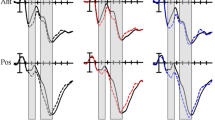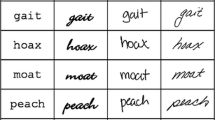Abstract
This paper reviews recent research on the effects of orthographic neighbors on visual word recognition in order to resolve apparently contradictory findings. The review reveals that the empirical evidence is not as contradictory as has been claimed. Neighbors have consistently been reported to facilitate responses to words in naming and lexical decision tasks. Inhibitory effects of neighbors appear to arise from sophisticated guessing strategies in the perceptual identification task or lexical decision strategies adopted in unusual stimulus environments. For English words, there is minimal evidence of competitive influences on lexical retrieval due to higher frequency neighbors. Such effects are more common in such languages as French and Spanish, perhaps because they embody a more consistent relationship between orthography and phonology. These findings provide important constraints on assumptions about the form of lexical representations and the parallel activation mechanisms assumed to underlie lexical retrieval.
Article PDF
Similar content being viewed by others
Explore related subjects
Discover the latest articles and news from researchers in related subjects, suggested using machine learning.Avoid common mistakes on your manuscript.
References
Andrews, S. (1989). Frequency and neighborhood effects on lexical access: Activation or search?Journal of Experimental Psychology: Learning, Memory, & Cognition,15, 802–814.
Andrews, S. (1992). Frequency and neighborhood effects on lexical access: Lexical similarity or orthographic redundancy?Journal of Experimental Psychology: Learning, Memory, & Cognition,18, 234–254.
Andrews, S. (1996). Lexical retrieval and selection processes: Effects of transposed-letter confusability.Journal of Memory & Language,35, 775–800.
Andrews, S., &Scarratt, D. R. (in press). Rule and analogy mechanisms in pronouncing nonwords: Hough dou peapel gnew wirds.Journal of Experimental Psychology: Human Perception & Performance.
Balota, D. A. (1990). The role of meaning in word recognition. In D. A. Balota, G. B. Flores d’Arcais, & K. Rayner (Eds.),Comprehension processes in reading (pp. 9–32). Hillsdale, NJ: Erlbaum.
Balota, D. A., &Chumbley, J. I. (1984). Are lexical decisions a good measure of lexical access?. The role of word frequency in the neglected decision stage.Journal of Experimental Psychology: Human Perception & Performance,10, 340–357.
Balota, D. A., &Chumbley, J. I. (1985). The locus of word-frequency effects in the pronunciation task: Lexical access and/or production?Journal of Memory & Language,24, 89–106.
Baluch, B., &Besner, D. (1991). Visual word recognition: Evidence for strategic control of lexical and nonlexical routes in oral reading.Journal of Experimental Psychology: Learning, Memory, & Cognition,17, 644–652.
Burnage, D. (1998).CELEX: A guide for users. Nijmegen: Centre for Lexical Information.
Carreiras, M.,Perea, M., &Grainger, J. (in press). Effects of orthographic neighborhood in visual word recognition: Cross-task comparisons.Journal of Experimental Psychology: Learning, Memory, & Cognition,23, 857–871.
Colombo, L. (1986). Activation and inhibition with orthographically similar words.Journal of Experimental Psychology: Human Perception & Performance,12, 226–234.
Coltheart, M. (1978). Lexical access in simple reading tasks. In G. Underwood (Ed.),Strategies of information processing (pp. 151–216). New York: Academic Press.
Coltheart, M., Curtis, B., Atkins, P., &Haller, M. (1993). Models of reading aloud: Dual-route and parallel-distributed-processing approaches.Psychological Review,100, 589–608.
Coltheart, M., Davelaar, E., Jonasson, J. T., &Besner, D. (1977). Access to the internal lexicon. In S. Dornic (Ed.),Attention and performance VI (pp. 535–555). Hilldale, NJ: Erlbaum.
Coltheart, M., &Rastle, K. (1994). Serial processing in reading aloud: Evidence for dual-route models of reading.Journal of Experimental Psychology: Human Perception & Performance,20, 1197–1211.
Content, A. (1991). The effect of spelling-to-sound regularity on naming in French.Psychological Research,53, 3–12.
Forster, K. I. (1976). Accessing the mental lexicon. In R. Wales & E. Walker (Eds.),New approaches to language mechanisms (pp. 257–287). Amsterdam: North-Holland.
Forster, K. I., &Davis, C. (1984). Repetition priming and frequency attenuation in lexical access.Journal of Experimental Psychology: Learning, Memory, & Cognition,10, 680–698.
Forster, K. I., &Dickinson, R. G. (1976). More on the languageas-fixed-effect fallacy: Monte Carlo estimates of error rates for F1, F2, F and min F.Journal of Verbal Learning & Verbal Behavior,15, 135–142.
Forster, K. I., &Shen, D. (1996). No enemies in the neighborhood: Absence of inhibitory effects in lexical decision and semantic categorization.Journal of Experimental Psychology: Learning, Memory, & Cognition,22, 696–713.
Frauenfelder, U. H., Baayen, R. H., Hellwig, F. M., &Schreuder, R. (1993). Neighborhood density and frequency across languages and modalities.Journal of Memory & Language,32, 781–804.
Gak, V. G. (1976).L’orthographie du francais [French orthography]. Paris: SELAF.
Gordon, B. (1983). Lexical access and lexical decision: Mechanisms of frequency sensitivity.Journal of Verbal Learning & Verbal Behavior,22, 24–44.
Grainger, J. (1990). Word frequency and neighbourhood frequency effects in lexical decision and naming.Journal of Memory & Language,29, 228–244.
Grainger, J., &Jacobs, A. M. (1996). Orthographic processing in visual word recognition: A multiple read-out model.Psychological Review,103, 518–565.
Grainger, J., O’Regan, J. K., Jacobs, A. M., &Segui, J. (1989). On the role of competing word units in visual word recognition: The neighborhood frequency effect.Perception & Psychophysics,45, 189–195.
Grainger, J., O’Regan, J. K., Jacobs, A. M., &Segui, J. (1992). Neighborhood frequency effects and letter visibility in visual word recognition.Perception & Psychophysics,51, 49–56.
Grainger, J., &Segui, J. (1990). Neighborhood frequency effects in visual word recognition.Perception & Psychophysics,47, 191–198.
Huntsman, L. A., &Lima, S. D. (1996). Orthographic neighborhood structure and lexical access.Journal of Psycholinguistic Research,25, 417–429.
Jacobs, A. M., &Grainger, J. (1992). Testing a semistochastic variant of the interactive activation model in different word recognition experiments.Journal of Experimental Psychology: Human Perception & Performance,18, 1174–1188.
Jacobs, A. M., &Grainger, J. (1994). Models of visual word recognition—Sampling the state of the art.Journal of Experimental Psychology: Human Perception & Performance,20, 1311–1334.
Johnson, N. F., &Pugh, K. R. (1994). A cohort model of visual word recognition.Cognitive Psychology,26, 240–346.
Landauer, T. K., &Streeter, L. A. (1973). Structural differences between common and rare words: Failure or equivalence assumptions for theories of word recognition.Journal of Verbal Learning & Verbal Behavior,12, 119–131.
Laxon, V. J., Coltheart, V., &Keating, C. (1988). Children find friendly words friendly too: Words with many orthographic neighbours are easier to read and spell.British Journal of Educational Psychology,58, 103–119.
Laxon, V., Masterton, J., Pool, M., &Keating, C. (1992). Nonword naming: Further exploration of the pseudohomophone effect in terms of orthographic neighborhood size, graphemic changes, spellingsound consistency, and reader accuracy.Journal of Experimental Psychology: Learning, Memory, & Cognition,18, 730–748.
Massaro, D. W., Taylor, G. A., Venezky, R. L., Jastrzembski, J. E., &Lucas, P. A. (1980).Letter and word perception: Orthographic structure and visual processing in reading. New York: North-Holland.
McCann, R. S., &Besner, D. (1987). Reading pseudohomophones: Implications for models of pronunciation assembly and the locus of word-frequency effects in naming.Journal of Experimental Psychology: Human Perception & Performance,13, 14–24.
McClelland, J. L. (1979). On the time relations of mental processes: An examination of systems of processes in cascade.Psychological Review,86, 287–330.
McClelland, J. L., McNaughton, B. L., &O’Reilly, R. C. (1995). Why are there complementary learning mechanisms in the hippocampus and neocortex? Insights from the successes and failures of connectionist models of learning and memory.Psychological Review,102, 419–437.
McClelland, J. L., &Rumelhart, D. E. (1981). An interactive activation model of context effects in letter perception: Part 1. An account of basic findings.Psychological Review,88, 375–407.
Michie, P. T.,Coltheart, M.,Langdon, R., &Haller, M. (1994).Effects of orthographic neighborhood size on visual word recognition: Behavioral, electrophysiological and computational evidence. Unpublished manuscript, Macquarie University.
Monsell, S., Doyle, M. C., &Haggard, P. N. (1989). Effects of frequency on visual word recognition tasks: Where are they?Journal of Experimental Psychology: General,118, 43–71.
Monsell, S., Patterson, K. E., Graham, A., Hughes, C. H., &Milroy, R. (1992). Lexical and sublexical translation of spelling to sound: Strategic anticipation of lexical status.Journal of Experimental Psychology: Learning, Memory, & Cognition,18, 452–467.
Morton, J. (1970). A functional model for memory. In D. A. Norman (Ed.),Models of human memory (pp. 203–254). New York: Academic Press.
O’Connor, R. E., &Forster, K. I. (1981). Criterion bias and search sequence bias in word recognition.Memory & Cognition,9, 78–92.
Paap, K. R., &Johansen, L. S. (1994). The case of the vanishing frequency effect: A retest of the verification model.Journal of Experimental Psychology: Human Perception & Performance,26, 1129–1157.
Paap, K. R., Newsome, S. L., McDonald, J. E., &Schvaneveldt, R. W. (1982). An activation-verification model for letter and word recognition: The word-superiority effect.Psychological Review,89, 573–594.
Patterson, J., &Morton, K. E. (1985). From orthography to phonology: A new attempt at an old interpretation. In K. E. Patterson, J. C. Marshall, & M. Coltheart. (Eds.),Surface dyslexia (pp. 335–359). Hillsdale, NJ: Erlbaum.
Peereman, R., &Content, A. (1995). Neighborhood size effect in naming words and pseudowords.Journal of Experimental Psychology: Learning, Memory, & Cognition,21, 409–421.
Perea, M., &Carreiras, M. (in press). Effects of syllable frequency and syllable neighborhood frequency in visual word recognition.Journal of Experimental Psychology: Human Perception & Performance.
Perea, M., &Pollatsek, A. (in press). The effects of neighborhood frequency in reading and lexical decision.Journal of Experimental Psychology: Human Perception & Performance.
Plaut, D. C., McClelland, J. L., Seidenberg, M. S., &Patterson, K. (1996). Understanding normal and impaired word reading: Computational principles in quasi-regular domains.Psychological Review,103, 56–115.
Plunkett, K., &Marchman, V. (1991). U-shaped learning and frequency effects in a multi-layered perception: Implications for child language acquisition.Cognition,38, 43–102.
Pugh, K. R., Rexer, K., &Katz, L. (1994). Evidence of flexible coding in visual word recognition.Journal of Experimental Psychology: Human Perception & Performance,20, 807–825.
Reichle, E.,Pollatsek, A.,Fisher, D. L., &Rayner, K. (in press). Towards a model of eye movements in reading.Psychological Review.
Rubenstein, H., Garfield, L., &Millikan, J. A. (1970). Homographic entries in the internal lexicon.Journal of Verbal Learning & Verbal Behavior,9, 487–494.
Sears, C. R., Hino, Y., &Lupker, S. J. (1995). Neighborhood size and neighborhood frequency effects in word recognition.Journal of Experimental Psychology: Human Perception & Performance,21, 876–900.
Segui, J., &Grainger, J. (1990). Priming word recognition with orthographic neighbors: The effects of relative prime-target frequency.Journal of Experimental Psychology: Human Perception & Performance,16, 65–76.
Seidenberg, M. S., &McClelland, J. L. (1989). A distributed, developmental model of word recognition and naming.Psychological Review,96, 523–568.
Shulman, H. G., Hornak, R., &Sanders, E. (1978). The effects of graphemic, phonetic, and semantic relationships on access to lexical structures.Memory & Cognition,6, 115–123.
Snodgrass, J. G., &Minzer, M. (1993). Neighborhood effects in visual word recognition: Facilitatory or inhibitory?Memory & Cognition,21, 247–266.
Spoehr, K. T., &Smith, E. E. (1973). The role of syllables in perceptual processing.Cognitive Psychology,104, 21–34.
Taft, M. (1979). Lexical access via an orthographic code: The basic orthographic syllabic structure (BOSS).Journal of Verbal Learning & Verbal Behavior,18, 21–39.
Taft, M. (1991).Reading and the mental lexicon. Hillsdale, NJ: Erlbaum.
Taft, M., &Radeau, M. (1995). The influence of the phonological characteristics of a language on the functional units of reading: A study of French.Canadian Journal of Experimental Psychology,49, 330–346.
Treiman, R. (1988). The internal structure of syllables. In G. Carlson & M. Tanenhaus (Eds.),Linguistic structure in language processing (pp. 27–52). Dordrecht: Kluwer.
Treiman, R. (1992). The role of intrasyllabic units in learning to read and spell. In P. B. Gough, L. Ehri, & R. Treiman (Eds.),Reading acquisition (pp. 65–106). Hillsdale, NJ: Erlbaum.
Treiman, R., Goswami, U., &Bruck, M. (1990). Not all nonwords are alike: Implications for reading development and theory.Memory & Cognition,18, 559–567.
Treiman, R., Mullennix, J., Bijeljac-Babic, R., &Richmond-Welty, E. D. (1995). The special role of rimes in description, use, and acquisition of English orthography.Journal of Experimental Psychology: General,124, 107–136.
Van Orden, G. C., &Goldinger, S. D. (1994). Independence of form and function in cognitive systems explains perception of printed words.Journal of Experimental Psychology: Human Perception & Performance,20, 1269–1291.
Wickelgren, W. A. (1969). Context-sensitive coding, associative memory, and serial order in (speech) behavior.Psychological Review,76, 1–15.
Author information
Authors and Affiliations
Corresponding author
Additional information
This review was prepared with support from Australian Research Council Grant AC9231195. I am grateful to Ken Forster for organizing the Cognitive Science Lexical Processing Workshop at the University of Arizona in November 1995, for which I initially prepared this review. My thanks are extended to Colin Davis for helping to collate the neighborhood statistics for the CELEX database.
Rights and permissions
About this article
Cite this article
Andrews, S. The effect of orthographic similarity on lexical retrieval: Resolving neighborhood conflicts. Psychonomic Bulletin & Review 4, 439–461 (1997). https://doi.org/10.3758/BF03214334
Received:
Accepted:
Issue Date:
DOI: https://doi.org/10.3758/BF03214334




